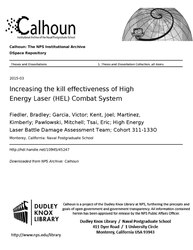File:Increasing the kill effectiveness of High Energy Laser (HEL) Combat System (IA increasingkillef1094545247).pdf

Original file (1,275 × 1,650 pixels, file size: 3.05 MB, MIME type: application/pdf, 166 pages)
Captions
Captions
Summary
[edit]| Increasing the kill effectiveness of High Energy Laser (HEL) Combat System
( |
||
|---|---|---|
| Author |
|
|
| Title |
Increasing the kill effectiveness of High Energy Laser (HEL) Combat System |
|
| Publisher |
Monterey, California: Naval Postgraduate School |
|
| Description |
A kill assessment system built into a High Energy Laser (HEL) Combat System will provide the U.S. Navy with a method to efficiently engage threats with an HEL effector, improve the weapon scheduling function, and help manage ship’s limited power resources. Near real-time Battle Damage Assessment (BDA) and Dwell Time determinations make up the new kill assessment system, which is simply called the BDA System. This system is a critical force-multiplier for ship survivability by limiting all HEL-target engagements to the minimum dwell time required for threat mitigation, while providing a mission kill interface to the Combat System for a calculated decision point to either re-engage the same threat or engage the next assigned target. This new BDA system concept for a shipboard HEL Combat System was analyzed in order to verify an expected increase in overall system efficiency and performance. The minimum desired increase of threat engagement efficiency was set at 25%. The proof of concept model developed for this project shows that adding a BDA system function to the HEL Combat System causes the system to exceed this threshold of efficiency. Subjects: high energy laser; battle damage assessment; layered defense; asymmetric threats; directed energy warfare; swarm; surface ship combat system assessment; anti-access area denial |
|
| Language | English | |
| Publication date | March 2015 | |
| Current location |
IA Collections: navalpostgraduateschoollibrary; fedlink |
|
| Accession number |
increasingkillef1094545247 |
|
| Source | ||
| Permission (Reusing this file) |
This publication is a work of the U.S. Government as defined in Title 17, United States Code, Section 101. Copyright protection is not available for this work in the United States | |
Licensing
[edit]| Public domainPublic domainfalsefalse |
This work is in the public domain in the United States because it is a work prepared by an officer or employee of the United States Government as part of that person’s official duties under the terms of Title 17, Chapter 1, Section 105 of the US Code.
Note: This only applies to original works of the Federal Government and not to the work of any individual U.S. state, territory, commonwealth, county, municipality, or any other subdivision. This template also does not apply to postage stamp designs published by the United States Postal Service since 1978. (See § 313.6(C)(1) of Compendium of U.S. Copyright Office Practices). It also does not apply to certain US coins; see The US Mint Terms of Use.
|
 | |
| This file has been identified as being free of known restrictions under copyright law, including all related and neighboring rights. | ||
https://creativecommons.org/publicdomain/mark/1.0/PDMCreative Commons Public Domain Mark 1.0falsefalse
File history
Click on a date/time to view the file as it appeared at that time.
| Date/Time | Thumbnail | Dimensions | User | Comment | |
|---|---|---|---|---|---|
| current | 01:00, 22 July 2020 |  | 1,275 × 1,650, 166 pages (3.05 MB) | Fæ (talk | contribs) | FEDLINK - United States Federal Collection increasingkillef1094545247 (User talk:Fæ/IA books#Fork8) (batch 1993-2020 #18646) |
You cannot overwrite this file.
File usage on Commons
The following page uses this file:
Metadata
This file contains additional information such as Exif metadata which may have been added by the digital camera, scanner, or software program used to create or digitize it. If the file has been modified from its original state, some details such as the timestamp may not fully reflect those of the original file. The timestamp is only as accurate as the clock in the camera, and it may be completely wrong.
| Short title | Increasing the kill effectiveness of High Energy Laser (HEL) Combat System |
|---|---|
| Author | Fiedler, Bradley, Garcia, Victor, Kent, Joel, Martinez, Kimberly, Pawlowski, Mitchell, Tsai, Eric, High Energy Laser Battle Damage Assessment Team, Cohort 311-133O |
| Software used | Fiedler, Bradley, Garcia, Victor, Kent, Joel, Martinez, Kimberly, Pawlowski, Mitchell, Tsai, Eric, High Energy Laser Battle Damage Assessment Team, Cohort 311-133O |
| Conversion program | Adobe PDF Library 11.0 |
| Encrypted | no |
| Page size |
|
| Version of PDF format | 1.4 |

